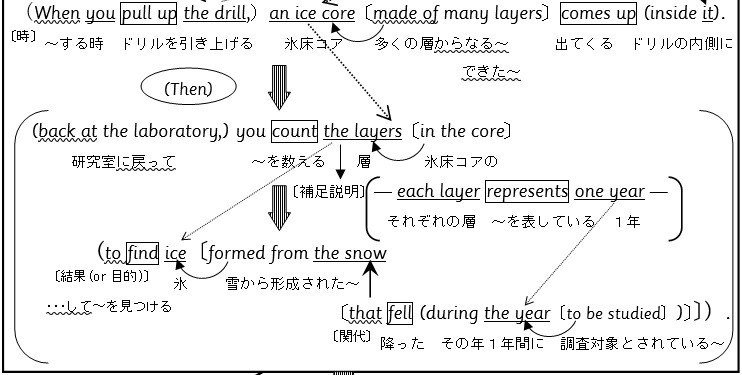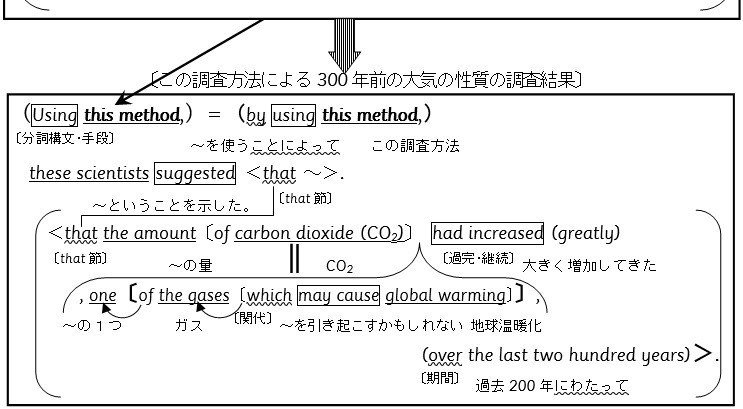1996年センター英語本試験 長文問題 第5問 本文解説②詳細内容理解
前回は、1996年センター英語本試験長文問題第5問本文の第2パラグラフの概要をつながりとまとまりを踏まえて解説しました。
今回は第2パラグラフの詳細内容理解について、つながりとまとまりをもう少し詳しく示しながら、1文単位の文構造、意味を解説していきます。
その前に、参考に、第2パラグラフのテクスト本文全体を再度掲載します。
第2パラグラフのテクスト本文
To find what air was like three hundred years ago, you use a drill in the shape of a hollow tube to cut deep into the layers of ice. When you pull up the drill, an ice core made of many layers comes up inside it. Then, back at the laboratory, you count the layers in the core — each layer represents one year — to find ice formed from the snow that fell during the year to be studied. Using this method, these scientists suggested that the amount of carbon dioxide (CO2), one of the gases which may cause global warming, had increased greatly over the last two hundred years.
前回に解説したように、この第2パラグラフでは、第1パラグラフの主題を受けて、主に、過去の大気の性質を調査する方法の詳細について説明されています。
・第1文〜第3文:300年前の大気の性質を調査する方法の詳細な手順
・第4文:この調査方法による300年前の大気の性質の調査結果
第1文
To find what air was like three hundred years ago, you use a drill in the shape of a hollow tube to cut deep into the layers of ice.

○ 第1文の解説です。まず大きな文構造を見ていきます。
・(To find <what air ~ ago>,):副詞句、不定詞の副詞的用法
・you:S
・use:V
・a drill:O
・(to cut ~ ice):副詞句、不定詞の副詞的用法
○(To find <what air was like (three hundred years ago)>, )
・To find:「~を発見するために」
不定詞の副詞的用法(目的)「~するために」
・ <what air was like (three hundred years ago)>
間接疑問文の名詞節で、To find [V'] の目的語 O'
○ 間接疑問文 <what air was like (three hundred years ago)>
・what air was like:「大気はどのよう(な状態)だったのか」
もとの疑問文は What was air like? 「大気はどのよう(な状態)でしたか?」
※ What is S like? = How is S?
「Sはどのよう(な状態・もの・感じ)ですか?」
・(three hundred years ago):副詞句「300年前に」
○ you use a drill「ドリルを使う」は問題ないかと思いますが、この you は 人々一般を表すもので訳す必要はありません。以降の文中の you も同様。
○ a drill〔in the shape of a hollow tube〕「〔中空管の形をした〕ドリル」
・O の a drill を核とする名詞句。形容詞句 〔in ~ tube〕が drill を修飾
・in the shape of ~:「~の形をした」
・hollow tube:「中空菅」
hollow [形]「空洞の、へこんだ」+ tube [名]「管」
○(to cut (deep) into the layers of ice)
「~して氷の層を深く切り込む[切り掘る]」
・to cut:不定詞の副詞的用法(結果)「・・・して~」(=and cut ~)
・cut into:V'' [熟語・他動詞]「~に切り込む」
※ cut と into の間にdeep [副]「深く」が割り込んでいる
・the layers of ice:O'' 名詞句「氷の層」
第2文
When you pull up the drill, an ice core made of many layers comes up inside it.

○ 第2文の解説です。まず、第1文とのつながりを確認します。
第2文は、調査手順において、第1文の内容の次の手順を示しています。
第1文の語句と次のようなつながりがあります。
・〔第1文〕a drill「ドリル」⇒〔第2文〕the drill「そのドリル」
・〔第1文〕the layers of ice「氷の層」
⇒〔第2文〕an ice core made of many layers
「多くの層からなる氷床コア」
the layers of ice に関しては、第1パラグラフ第4文の layers of ice とも
つながりがありますので重要です。このつながりは要マークです。
※ the drill のつながりに関しては、詳しめにつながりを示すために取り上
げていますが、調査に用いる道具にすぎず、読解の際に、第1文と第2
文のつながり、第2文の意味が適切に理解できれば、特にアンダーライ
ンなどする必要はないかと思います。
○ 第2文の大きな文構造を見ていきます。
・(When you pull up the drill,):時を表す副詞節
・an ice core:S「氷床コア」
・comes up:V「出てくる、上がってくる」
・(inside it):副詞句「その内側に」
○ 副詞節(When you pull up the drill,)
・When S+V~:S が V する時
・you:S'
・pull up:V'「~を引き上げる」
・the drill:O'
○ an ice core 〔made of many layers〕「〔多くの層でできた〕氷床コア」
・S の a ice core を核とする名詞句
形容詞句の〔過去分詞 made of many layers 〕が an ice core を修飾
・be made of ~:「<材料>で[から]できている、作られている」
※ an ice core:「氷床コア」。南極や北極付近の氷床からドリル掘削機に
よって取り出された、長い管状の形をした氷の資料。
<参考リンク>
http://caos.sakura.ne.jp/tgr/research/icecore
https://ja.wikipedia.org/wiki/%E6%B0%B7%E5%BA%8A%E3%82%B3%E3%82%A2
○ (inside it)「それ[=ドリル]の内側に」
・inside ~: [前]~の内側に
・it は、同じ第2文中の副詞節の目的語 O' の the drill を指している。
第3文
Then, back at the laboratory, you count the layers in the core — each layer represents one year — to find ice formed from the snow that fell during the year to be studied.

○ 第3文の解説です。まず、第2文とのつながりを確認します。
第3文も、調査手順において、第2文の内容の次の手順を示しています。
・〔第2文〕an ice core made of many layers
「多くの層からなる氷床コア」
⇒〔第3文〕the layers in the ice「その氷床コアの層」
また、第3文の文頭につなぎ語 Then「それから」があることからも、
この文が前文の内容の次の手順を表すことが明らかです。
○ 第3文の大きな文構造を見ていきます。
・Then:[副] 「それから」
・(back at the laboratory):副詞句「研究室に戻って」
※ back at ~「~に戻って」
・you:S
・count:V「~を数える」
・the layers:O「その層」
・— each layer represents one year —:the layers の補足説明として挿入
・(to find ice ~ to be studied):副詞句、不定詞の副詞的用法
○ the layers〔in the core〕「〔その氷床コアの〕層」
・O の the layers を核とする名詞句
形容詞句の〔in the core〕が a ice core を修飾
・the core は前文の an ice core を受けており、core の前に ice が省略
○ — each layer represents one year —
・O の the layers を補足説明する挿入文
・each layer:S'「それぞれの層」
・represents:V’「~を表す」
・one year:O'「1年」
○ to find ice formed from the snow that fell during the year to be studied の
大きな文構造
・to find:不定詞の副詞的用法(結果)「・・・して~」(=and find~)
※「目的」としても解釈可能だがここでは「結果」と考える。
「(氷床コアの層を数え)て~を見つける」
・ice:find [V''] の O''
・〔formed from the snow that fell during the year to be studied〕
長い形容詞句として O''の ice を修飾。中にさらに関係詞節、
その中にさらに不定詞の形容詞的用法の形容詞句を含む構造
○ ice〔formed from the snow ~ studied〕「〔~雪から形成された〕氷」
・ice を核とする長い名詞句
形容詞句の〔過去分詞 formed from the snow ~〕が ice を修飾
・form O from ~:「~から O を形成する」
○ the snow〔that fell (during the year ~ studied)〕
「〔(~その1年間に)降った〕雪」
・the snow を核とする名詞句
関係詞節〔that fell (during the year ~ studied)〕が the snow を修飾
・fell:関係詞節の動詞 V'''「降った」
・(during the year ~ studied):関係詞節の、期間を表す副詞句
○ the year〔to be studied〕「〔調査(対象と)されている〕年」
・the year を核とする名詞句
不定詞の形容詞的用法の形容詞句〔to be studied〕が the year を修飾
・文の形にすると、the year was studied.「その年が調査されていた」
第4文
Using this method, these scientists suggested that the amount of carbon dioxide (CO2), one of the gases which may cause global warming, had increased greatly over the last two hundred years.

○ 第4文の解説です。まず、第3文までとのつながりを確認します。
第4文始めの this method「この方法」で、第1文〜第3文で手順を詳し
く説明した調査方法全体を受けています。
そして、suggested that節「~ということを示した」で、その調査結果を
示しています。
○ 第4文の大きな文構造を見ていきます。
・(Using this method,):副詞句、分詞構文
・these scientists:S「これらの科学者達」
・suggested:V「~を示した」
・<that ~ years>:O 、that節「~ということ」
○ 副詞句(Using this method,)「この方法を使うことによって」
・手段を表す分詞構文「~することによって、~して」
・この文では、by ~ing で言い換え可能(=By using this method,)
○ that節「~ということ」<that ~ years>の大きな文構造
・the amount:S「量」
・had inceased:V「増加してきた」過去完了・継続
・(greatly):副詞「大きく」
・(over the last two hundred years):期間を表す副詞句
○ the amount〔 of carbon dioxide (CO2)〕「〔CO2の〕量」
・the amount を核とする長い名詞句。
形容詞句の〔 of carbon dioxide (CO2)〕が the amount を修飾
○ , one【of the gases〔which may cause global warming〕】
・直前の名詞 carbon dioxide (CO2) の言い換え、one を核とする名詞句
・one【of the gases〔関係代名詞which ~〕】:「~するガスの1つ」
・one of the 複数名詞:「~の(うちの)1つ」
○ the gases〔which may cause global warming〕
「〔地球温暖化を引き起こすかもしれない〕ガス」
・the gases:関係詞節〔which ~ global warming〕が修飾する名詞
・which:主格の関係代名詞 S'
・may cause:関係詞節の動詞 V' 「~を引き起こすかもしれない」
・<原因となるもの>cause<結果>
「<原因となるもの>が<結果>を引き起こす、もたらす」
・global warming:関係詞節の目的語 O'「地球温暖化」
○ (over the last two hundred years)「過去200年にわたって」
・over <期間>:「<期間>にわたって」
・the last [またはpast] <数>years:「過去<数>年、ここ<数>年」
最後に、第2パラグラフの1文単位の詳細解説の全体図です。

今回も、最後まで解説をご覧頂き、本当にありがとうございました。
心より感謝申し上げます。
もし、何かお気付きの点などございましたら、コメント、メッセージなど頂けると大変ありがたく存じます。
現在、英語教育関連職を希望して求職中の身ですので、気に留めて頂き♡やフォロー、twitterかnoteでのコメントなど頂けると大変励みになります。
今後とも、何卒よろしくお願い申し上げます。
この記事が気に入ったらサポートをしてみませんか?
